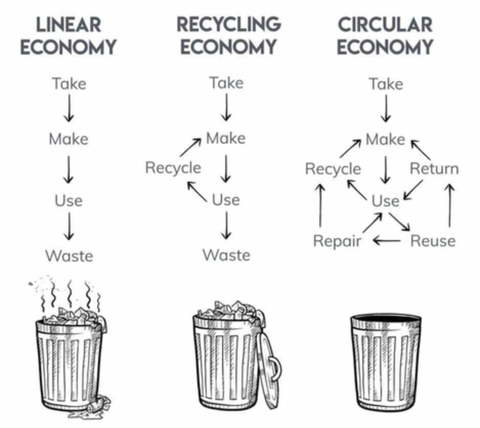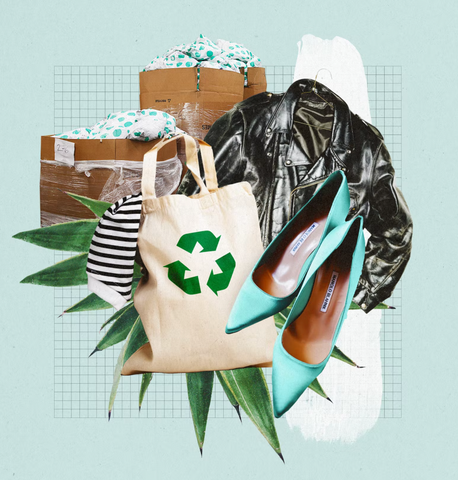Once upon a time, there was a man who handcrafted shoes out of leather and wood. He sold them for a generous sack of shillings and the buyer would own that pair of shoes for the rest of their life. If anything happened to those shoes, the owner would take them to a cobbler to repair.
In the 1960's, plastic injection molding made it so that rubber soles and shoes could be made 100 times faster and 100 times cheaper. Mass manufacturing made it so that buying a new pair was cheaper than repairing. The cobbler goes out of business and the modern person can afford to buy 100 pairs of shoes in their lifetime, instead of clutching onto the 1 pair. UH OH! All of a sudden our oceans are full of floating nike symbols. What the heck happened?
 Remember these?! Mass production of Model Ts in the 1910s
Remember these?! Mass production of Model Ts in the 1910s
A once slow and circular economy where every shoe, bit of food, piece of packaging, etc, was highly valued, reused, and taken care of because they were expensive and laborious to make. With the introduction of factories and manufacturing, goods became inexpensive and easy to make at scale. Scarce and expensive things were all of a sudden plentiful, affordable, and ultimately disposable because they were cheaper than repair or reuse.
So at breakneck speeds, resources are now extracted from the earth, sent to factories, into stores, into houses, and then landfills and oceans. The greenhouse gas emissions and pollution associated with this pace of resource extraction, production, shipping, and even recycling, have become quite alarming and unsustainable for our planet to provide a nice little home for our species. Things are moving in one straight, fast line in the wrong direction. The Linear Economy.
In recent years, there has been a shift back towards a circular economy. Oxford dictionary defines the circular economy as "an economic system based on the reuse and regeneration of materials or products, especially as a means of continuing production in a sustainable or environmentally friendly way." Essentially, we're wanting to bend and stretch the line in the traditional linear economy to get the most use out of our resources and goods to reduce global warming and pollution. There are 3 principles of the circular economy that loosely resemble the age-old adage “reduce, reuse, and recycle.”

The first principle of the circular economy entails eliminating unnecessary waste in the first place i.e. “reduce.” Lush (where your sister gets her bath bombs), for example, has redesigned some of its product packaging to be "naked", meaning instead of selling products in their liquid forms (and thus in plastic bottles), they're sold as solid formations, free of wasteful packaging. Since 2005, Lush has sold nearly 50 million naked shampoo bars globally, eliminating over 150 million plastic shampoo bottles. Cliffset is portable cutlery with its own dishwasher, making it easier for people to reliably keep their reusables clean and on hand, reducing the need for single-use plastic food ware while on the go.
The second principle describes how we “reuse” already manufactured or harvested products, and how we eventually utilize the waste material at its end of life. In contrast to the linear economy style of 'fast fashion' where companies will design cheap articles of clothing that last only for a few wears before falling apart, Patagonia's Care & Repair program offers repair resources and services so customers can extend the life of their durable garments. Pulp Pantry heroically uses, or "upcycles," the otherwise wasted pulp from juice production to create delicious and nutritious chips.

The third principle of the circular economy focuses on switching natural resource extraction and depletion towards using regenerative energy and resources. One startup called Dandelion is providing heat and cooling through below house pipes that reach down and tap into the earth’s natural heat, eliminating the need to combust natural gas. This is a renewable energy source that doesn’t require adding additional carbon to our atmosphere.
The “recycle” bit of the adage can be looked through a lens of how we extract resources in a way that is slower than the earth's ability to regenerate them, so as to not deplete it permanently. For example, we should fish slower than the species rate of repopulating, to ensure they don’t go extinct. “Recycling” in the circular economy can mean planting different crops in new areas so as to not deplete the soil of nutrients for future potential to grow, for example.
But doesn’t “recycle” mean throwing your plastic water bottles in the blue bin so that it can get made into new bottles? Unfortunately, this model of consumption fits into the linear economy because only 5% of all plastics actually get recycled. We’re making more than we can renew so the rest is building up in landfills and waterways, causing an over-reliance on fossil fuels from which they are made and creating chemical and microplastic pollution in the ocean.
What does this mean for us?
Reduce how much you consume, avoiding plastic wrapped foods and indulgent clothes shopping because they’re the bulk of our consumption. Shop for unpacked produce and support a refill store near you. Attend a clothing swap or check your local thrift shop for a new look.
Reuse your things. Even if it was a cheap purchase, learn to value items in terms of the resources that go into making it and its end of life. Learn to care and repair your more durable items, and don’t throw away food.
Recycle the earth’s resources. In the circular economy, this actually means supporting business models that use regenerative energy, sustainability farm, and responsibly mine and harvest. Traditional recycling doesn’t work and was sort of a greenwashing campaign in the first place.


